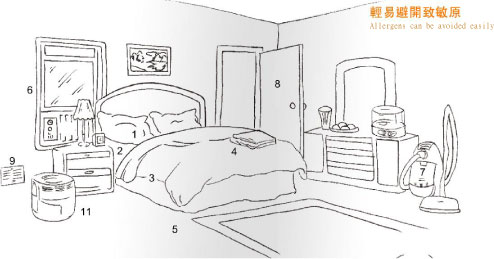Allergen Avoidance
Allergens are present everywhere. They exist throughout the environment, both indoors and outdoors. Although it is impossible to lead a normal life and avoid allergens 100% of the time, you can reduce allergen exposure. By taking what allergy researchers call the "top five" prevention actions - encase, wash, vacuum, wipe and dehumidify - you can control your environment and significantly reduce your exposure to allergens.
Expert's advice : Allergen Avoidance is the first line of defense in dealing with allergy and asthma
Actually all the guidelines on managing allergy and asthma are recommending ALLERGEN AVOIDANCE as the very first step to control the symptoms, here are a few statements from the professional bodies:
Environmental allergen avoidance is one of the 4 primary goals of good asthma management.
-
USA National Asthma Education and Prevention Program Asthma Guideline
The most important aspect of the management of patients with life-threatening allergies is avoidance. - American Academy of Allergy, Asthma and Immunology (AAAAI) Position Statements
There is a strong correlation between allergic sensitisation to common aeroallergens and the
subsequent development of asthma.
-
British Guideline on the Management of Asthma
Simple steps to be taken to reduce household allergens

Basic Steps
- Encase your pillow or wash it every week in hot water.
- Encase your mattress in an allergen barrier.
- Encase your box spring and comforter in an allergen barrier, or, wash your comforter every week in hot water.
- Wash blankets and bed linens (sheets and pillowcases) every week in hot water.
- Remove bedroom carpeting if at all possible. If unable to remove carpeting
- Clean carpeting using specialized carpet treatments that denature or deactivate allergens
- Use carpet treatment that kill dust mites
Secondary Steps
- Remove or minimize upholstered furniture. Use window shades rather than blinds or curtains.
- Frequently clean your carpeting:
- Vacuum weekly wearing a face mask
- Use a HEPA vacuum for maximum allergen containment
- Use exhaust filters and multi-layer bags to upgrade your vacuum
- Keep surfaces and storage clean and dry
- Wipe furniture, drawers, closets and other surfaces with a treated cloth.
- Keep clothing in a closed closet
- Get rid of dust collectors
- In homes with forced hot-air heating/cooling systems:
- Use a central filter in the furnace
- Cover vents with filters or close bedroom vents and use an electric heater
- Control humidity levels:
- Moulds and dust mites thrive in high humidity; keep levels between 35-40%
- Use air conditioning and dehumidifier units
- Use HEPA air cleaner to remove airborne allergens
